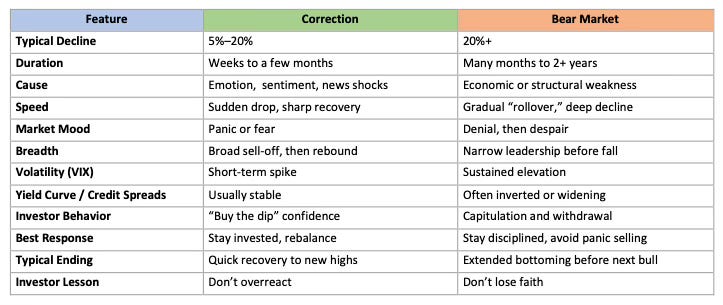How to Detect a Bear Market
And Why the Answer May Surprise You
📌 The Quick Hit
If you could figure out when the next bear market is coming, you’d not only be a hero - you’d potentially save your portfolio from disaster.
So how do you do that?
Most investors start with the wrong question:
“When is the next bear market coming?”
A better one is:
“What’s the difference between a correction and a bear market?”
Understanding that distinction will spare you a lot of stress - and possibly a few sleepless nights - on your way to reaching your financial goals.
Because as readers of The Other Side of Obvious know, markets don’t behave the way we think they should. And neither do we. (See below👇, for example)
Afraid of Heights?
Happy Monday! It looks like US markets are setting records again. So, I couldn’t help commenting.
📖 The Basics: Correction vs. Bear Market
Correction:
A correction is a short-term pullback - typically a decline of less than 20% - that plays out over weeks or months.
It’s usually driven by sentiment, not fundamentals.
Something spooks investors (a headline, a crisis, a war, a rumor), and the market temporarily sells off.
More often than not, markets rebound sharply (which is why remaining invested is the best strategy).
Bear Market:
A bear, by contrast, creeps in quietly.
It begins with a slow “rollover,” then gains downward momentum. Eventually, prices fall 20% or more from their highs - although usually with a big drop months after it began.
Corrections feel loud: dramatic drops, emotional headlines.
Bear markets start with whispers.
🕵🏻♀️ Detection vs. Declaration
Bull markets don’t die with a bang 👉 they die with a sigh.
The end of a bull run is almost never announced.
That’s why investors often mistake a correction for the start of a bear and a bear for “just another dip.”
Even the COVID crash of 2020 - the fastest bear in modern history - was the exception that proved the rule. The recovery was just as sharp because the cause (a global shutdown) was clear, immediate, and reversible.
But most bear markets conceal their real trouble.
The hidden issue isn’t on the front page…not yet.
🧨 Hidden Triggers
Take 2008. Everyone remembers “the housing bubble,” “subprime,” and “Lehman.”
Few remember FAS 157 - a change in accounting rules in 2007 that required banks to mark assets to market, even when those markets had no bids.
A technical tweak few investors noticed helped trigger a global meltdown.
Bear markets are like that. The trigger isn’t always the obvious one - it’s the one that quietly breaks the system’s plumbing.
📉 So… How Do You Detect a Bear Market?
Short answer:
Be in one.
Long answer:
You can’t detect a bear market ahead of time with precision - but you can read the signs that risk is rising.
Here’s a few things to watch. Rarely is it one thing, but a combination of issues, such as:
1. Market Breadth
When fewer and fewer stocks are driving market gains, that’s a red flag. Narrow breadth means the rally is losing support.
2. Yield Curve Inversion
When short-term Treasury yields rise above long-term yields, it often signals tightening credit and slower growth ahead. Most recessions - and bear markets - follow an inverted yield curve by 6–18 months.
3. Credit Spreads
When the gap between junk bond yields and Treasuries widens, it means investors are demanding higher compensation for risk - a classic early warning.
4. Volatility Spike (VIX)
Volatility indexes rising from historically low levels often indicate fear is creeping back into the market.
5. Investor Sentiment
Euphoria is the last stage of a bull market.
When everyone you know - including your dentist and your dog groomer - is giving stock tips, it’s usually late in the game.
Conversely, when sentiment is gloomy and no one wants to touch stocks, you’re likely closer to the bottom than the top.
The mood of the market is often more useful than the news.
Corrections happen when fear flares up.
Bears form when optimism refuses to die - even as the fundamentals start to crumble.
🗞️ Look Beyond the Headlines
The real causes of bear markets aren’t usually visible until after the fact.
By the time they’re front-page news, the damage is already done.
So instead of guessing when the bear will appear, focus on positioning your portfolio so that it can survive one.
With detection, you have time to make portfolio adjustments.
Diversification, patience, and cash reserves do far more for your returns than trying to time the cycle.
✨ Closing Thoughts
Everyone wants to spot the next bear.
But here’s the truth: the market never rings a bell at the top - or the bottom.
By the time you know you’re in a bear market, you already are.
The trick isn’t to predict it.
It’s to prepare for it - and to stay sane enough to recognize that bears, like bulls, are part of the natural order.
Because every bear eventually hibernates.
And every new bull starts quietly - just when most investors stop listening.
🚀 Up Next:
Sunday - “Does the Path to Your Goals Really Matter?”
Thursday - “The Truth About US Deficits”
This publication is for brains, not bets. The Other Side of Obvious shares ideas, stories, and general financial information—not personalized investment, tax, or legal advice. Investing comes with risk (including losing money). Talk to a pro before you act. Please take time to read these important disclosures before you get started.




